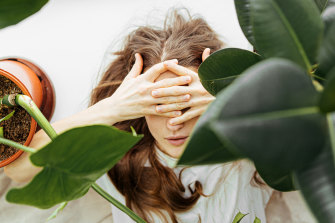
If you’re sick of staring at the same four walls, you may be tempted to join the legions of people who’ve breathed fresh life into their homes by bringing in a plant.
While interest in houseplants has grown in recent years, the pandemic has seen a surge in those wishing to welcome some greenery inside, with the Nursery Industry Statistics 2019-20 survey finding the total sales volume of the indoor plant category grew by 9 per cent in that financial year.
If starting your collection, choose are hardy plants and can handle lower light levels, including, devil’s ivy, mother-in-law’s tongue, or peace lily.Credit:Stocksy
That trend is likely to continue, says Jason Chongue, creative director at The Plant Society. He’s seen a rise in people not only buying houseplants, but also greenery to adorn balconies and small courtyards. And since people are spending more time at home than ever before, he says they’re focusing more on their surroundings: “They’re saying, ‘If I add plants here, it brings so much joy to me.’ ”
Interior stylist Alana Langan gets why we want to bring a touch of nature indoors. The co-founder of Melbourne’s Ivy Muse, a botanical wares design studio, and co-author of Nature Style: Cultivating Wellbeing at Home with Plants, says houseplants don’t just beautify a room, they also help reduce stress. Just looking at plants, she adds, reduces blood pressure while boosting self-esteem and enhancing mood.
Studies back such claims, including a randomised controlled trial from 2009 that looked at patients recovering from surgery. One group was given a plant in their room during that time; the other wasn’t. The study found that the group with a live plant in their room had “significantly more positive physiologic responses” – evidenced by lower blood pressure, and less pain, anxiety and fatigue – than the other group.
Langan also says thast tending to plants – spending time trimming off brown leaves or giving them fertiliser or water, for instance – is an act of mindfulness that can also lower stress levels. “You can really slow down and just be present with them.”
Sold on the idea of having an indoor plant, but don’t know where to begin? Langan suggests starting with one which is “really hardy” and can handle lower light levels such as a devil’s ivy, mother-in-law’s tongue or peace lily. Chongue nominates the Swiss cheese plant, Monstera deliciosa, and herbs such as rosemary as great first purchases.
While you may be tempted to splash serious cash on a bigger buy (we’re looking at you, fiddle-leaf figs), Langan suggests starting simple and “building up your green thumb” from there.
As you learn the art of keeping a plant alive, Langan says you might like to wade further into a realm known as biophilic design, which is “the theory that we, as humans, are innately drawn to other living things” It’s the reason we love looking at sunsets and going for walks in the forest, she explains.
But instead of having to venture outdoors to benefit, Langan says biophilic design allows you to reap those rewards from the comfort of your couch. In practical terms, you can keep windows open for fresh air, allow soothing, nature-based scents such as lemon myrtle to waft through your house, or introduce natural materials such as handmade ceramics, rattan and wood into your home. Of course, houseplants play a key role, too.
The beauty of biophilic design, Langan explains, is that it creates a nurturing environment in your home that naturally helps you de-stress. In other words, she says, biophilic design can turn your home into a sanctuary.
This article appears in Sunday Life magazine within the Sun-Herald and the Sunday Age on sale September 19. To read more from Sunday Life, visit The Sydney Morning Herald and The Age.
Make the most of your health, relationships, fitness and nutrition with our Live Well newsletter. Get it in your inbox every Monday.
Most Viewed in Lifestyle
From our partners
Source: Read Full Article
